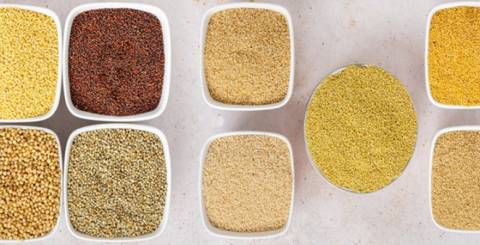Millets Benefits - Positive, Negative and Neutral Millets

Abstract
Millets are a profoundly different group of little cultivated grasses, broadly grown all over the world as cereal yields or grains for cattle fodder and human food. Most species by and large alluded to as millets have a place with the clan Paniceae, however, a few millets likewise have a place with different other taxa. People in India used to consume the traditional food of millet but wheat has changed the trend and led to various health issues such as diabetes and associated disorders though it has some benefits as well. In the further section, we shall discuss the millets (positive, neutral and negative) and their benefits. Let's see!!
Introduction
Millets are significant harvests in the semiarid jungles of Asia and Africa (particularly in India, Niger, Mali and Nigeria,), with 97% of millet creation in developing nations. This yield is inclined because of its efficiency and short developing season under high-temperature and dry conditions. Millets are native to many pieces of the world. The most broadly grown millets are pearl millets and sorghum, which are significant yields in India and portions of Africa. Finger millet, proso millet, and foxtail millet are likewise significant harvest species. Millets have been consumed by people for around 7,000 years and possibly had "a critical job in the ascent of multi-crop horticulture and settled cultivating social orders.
Millets Can be Divided into Three Subgroups
- Positive millets
- Neutral millets
- Negative millets
Description
1. Positive Millets
Positive millets include foxtail millet, browntop millet, kodo millet, barnyard millet and Little millet
2. Neutral Millets
It includes sorghum (jawar), pearl millets (bajra), finger millet (ragi), proso millet and corn
3. Negative Millets
Negative millets are wheat and paddy (rice).
1. Positive Millets
1. Foxtail millets
It is also known as kangani. It has Italian origin. It has fibre of around 7% It acts as a brain tonic and is essential in neurological problems. It also affects the respiratory system positively and is beneficial in respiratory disorders. It helps in sciatica as it helps in the skeletal system. Foxtail millets are also high in protein content. It helps with a number of psychological and neurological problems and works amazingly in epilepsy, arthritis and Parkinson’s disease.
2. Brown top Millets
Browntop millets are also known as hari kangani. It has American origin. It works amazingly in different systems of the body namely the neurological system, digestive system and skeletal system. Browntop millets work amazingly in the condition of chronic constipation. It has a fibre content of 12.5 %. Furthermore, browntop millets have good results in arthritis, hypothyroidism, eye disorders, thyroid problems, hypertension and obesity.
3. Kodo Millets
It is pinkish in colour. It is best used in haematological problems. It helps in blood cancer, anaemia, bone marrow issues, allergic conditions, leukocytosis, thrombocytopenia, ITP, and the disorders of the raktavaha srotas. It helps in maintaining the levels of creatinine and reduces cholesterol and triglycerides. This has a number of health benefits. Patients with blood disorders must consume the Kodo millets at the latest for three days for breakfast, lunch and dinner as well. It has fibre content of about 10% Kodo millets are of best help in insomnia, diabetes, weak immunity, constipation, anaemia and impurities of the blood.
4. Barnyard Millets
Barnyard millets are also known as Japanese or German millets. These millets are of choice in the disorders of the liver. It has around 11 % fibre. It helps wonderfully in soft tissue disorders and magically works in hepatomegaly and splenomegaly. Barnyard millet excels with its goodness in managing the conditions of the liver, kidney, spleen, excessive bad cholesterol and endocrine glands.
5. Little Millets
Little millets contain around 10 to 11 per cent fibre. This is known as kutki in Punjabi. It works impeccably in the disorders of the reproductive system such as azoospermia, erectile dysfunction and various others as well. Further, it balances the hormones in the body and hence is beneficial in female reproductive system issues. With the above-mentioned properties, little millets are helpful in PCOD (polycystic ovarian disease), uterine fibroid, male and female infertility
2. Neutral Millets
1. Sorghum
Sorghum is known as jowar and is considered neutral millet thus can be consumed regularly according to the season ongoing. It is gluten-free and has no glycemic index. It works nicely in nerve degeneration conditions. It is a rich source of magnesium and phosphorus. It has a hot potency. Sorghum reduces inflammation. It contains antioxidants that help in fighting the ageing signs and also it also exhibits anti-cancer properties. It has 4 g of fibre
2. Pearl Millet
Pearl millet is also known as Bajra and is a great component of a diabetic diet, that provides a stable glucose level in the bloodstream. It helps in lowering the cholesterol level, thus beneficial in heart patients. It is gluten-free. It is useful in stomach ulcers and acidity. Due to its higher fibre content of 1.3g, it helps in relieving constipation. It is a good source of protein. It is good for lowering high blood pressure.
3. Finger Millet
The minerals, fibre and nutrients found in finger millet can give significant medical advantages. The potassium found in finger millet can assist with keeping your kidneys and heart working appropriately. Potassium likewise assists your nerves with communicating signals, which permits your cerebrum and your muscles to cooperate without a hitch. Finger millet is also known as Ragi, according to Ayurveda, it is tridosha shamak, which helps in the burning sensation in the hands and feet.
- It has a fibre content of around 3.6 g.
- It supports the good bacteria in the gut
- Finger millet is an excellent source of niacin, vitamin A, vitamin B, calcium, iron, phosphorus, potassium, and antioxidants.
- Finger millets controls bad cholesterol and thus helps in atherosclerosis
- A low glycemic index makes it a useful meal for the diabetic patient.
4. Proso Millet
Proso millet is of great use in diseases of the nervous system as it contains a good amount of lecithin as it helps in strengthening the nervous system. The Proso millets are beneficial in reducing the bad cholesterol levels in the body as it contains phytic acid that reduces bad cholesterol level. It acts as an anti-ageing agent due to its antioxidant richness that removes free radicals from the body. It works wonderfully in diseases of the skin. As it is devoid of gluten this is a good diet for celiac patients. As it contains high amounts of magnesium it is helpful in checking the levels of glucose in the patient with diabetes and hence controls the type 2 diabetes. Further, it has a decent amount of calcium thus helping in strengthening the bones. It has a fibre content of 2.2 g.
5. Corn
Corn is known as corn silk and is commonly known as Makka/makki. It is of great help in prostatomegaly, kidney dysfunction and bed wetting. It manages cystitis, oedema, kidney stones, and urinary infections as it acts as a diuretic. It promotes and boosts the health of the kidney. It also helps in reducing cholesterol levels and blood glucose levels. It helps in anaemia, protects the heart, helps in weight gain and is good for the eyes and skin. It helps in the prevention of cancer and promotes healthy cell division.
3. Negative Millets
1. Wheat
Wheat is a new grain that provides energy to the body and has a high glycemic index but contains some proteins such as gluten that cause problems in some patients that are intolerant to gluten. Further, it has several benefits and it has been in regular use in India particularly in the north. It has 1.2 g of fibre.
2. Rice (paddy)
Rice is widely grown all over India and is a source of instant and fast energy. It is generally used in some of the states of India every day. It has 0.2 g of fibre. Though a good source of instant energy and easy to digest and helps in weight gain and though not so good for gut health due to its low fibre content it can cause constipation.
Conclusion
Millets are of great help in managing diseased conditions and maintaining the health status of a man and thus with property these also help in achieving the objective of Ayurveda. Millets are of great help in almost every condition and are a great source of fibre. Furthermore, due to the low glycemic index, positive and neutral millets are helpful in maintaining normal blood sugar levels. Millets were in use in ancient times and people were healthy but today the new grains have taken the place of ancient millets. And further chemical fertilisers and pesticides have made them more harmful. Thus this is the need of time that we must switch our diet to millets and stay positive and healthy and we should also spread the usefulness of the positive and neutral millets and discard the use of harmful wheat and rice at earliest.
Similar Articles
The winter season brings chilly mornings, shorter days, and a natural shift in our eating and lifestyle habits. While many people focus on protecting their skin or boosting immunity during winter, gut health often gets overlooked.
Coping with Ulcerative Colitis can be challenging, and many people look toward gentle, natural pr
Fatty liver, known as Yakrit Roga in Ayurveda, occurs when excessive fat accumulates in the liver cells. This condition is becoming increasingly common due to sedentary lifestyles, poor diet, stress, and unhealthy eating habits.
Epilepsy is a chronic neurological condition marked by recurrent seizures — sudden bursts of electrical activity in the brain that can cause changes in behavior, awareness, or movement.
The ketogenic diet is one of the most popular dietary patterns globally, primarily adopted for weight loss. It is a high-fat, low-carbohydrate, and moderate-protein eating plan that promotes the production of ketones in the liver.
When it comes to achieving fitness and health goals, selecting the right diet plan can be challenging. Among the myriad of options available, the CICO (Calories In, Calories Out) diet and the KETO (Ketogenic) diet are two popular approaches.
Boost your health with nutrient-rich fruits and vegetables! Discover the best options to enhance immunity, energy, and overall well-being in your daily diet.
Diet and energy metabolism have been shown to affect gene expression greatly, which in turn influences human health and disease. Epigenetics serves as a mechanistic link between energy metabolism and gene expression control.
Dealing with digestive problems on a regular basis can be difficult. An upset stomach, gas, heartburn, nausea, constipation, or diarrhea are all too prevalent and can have a negative impact on your quality of life. The good news is that simple dietary modifications can do wonders for your gut health, potentially relieving many issues









